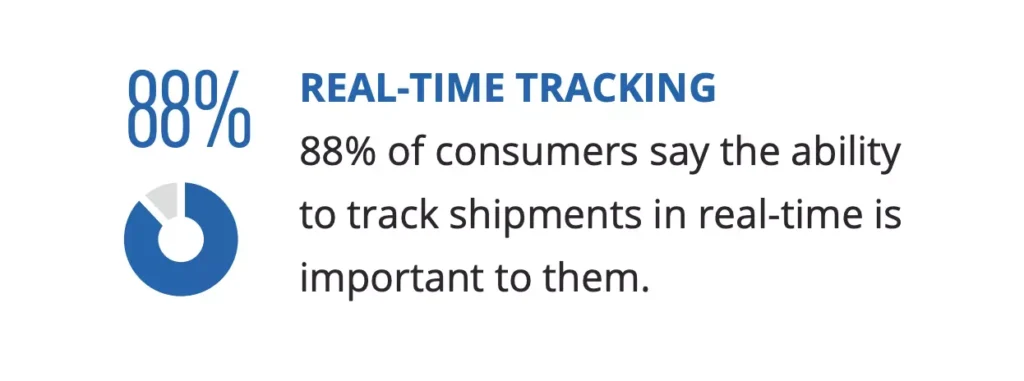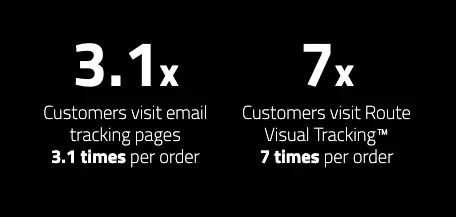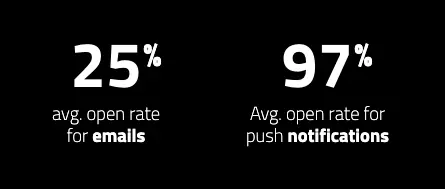Here’s a little story about Sting and package tracking.
Picture it: August 11, 1994.
It was an impossibly warm summer day in New Hampshire.
Dan sat in his parents’ living room, nervously tapping on his PowerBook 100.
“This better work,” he anxiously mumbled to himself.
*Ding*
Dan’s eyes shot up toward the screen to see a pixelated notification that read two never-before-seen words: “Order complete.”
“I can’t believe it!”
Within moments, $12.46 hit his bank account, and he quickly started packing Sting’s Ten Summoner’s Tales to be shipped to his buddy in Philadelphia.
An order confirmation email was deployed and the rest is history.
Behold, the birth of ecommerce as we know it. The first transaction made completely online with a credit card and securely purchased using encryption technology.
We love a good anecdote, but the truth is that Dan Kohn’s sale of Sting’s iconic album isn’t the only innovation enriching society in 1994.
There’s no two ways about it, it was a big year all around. Disney graced us with the Lion King, the domain Amazon.com was registered, the average cost of a gallon of gas was $1.09, Michael Jordan was taking hacks in the minor leagues, people were still buying CDs, and the best part for wannabe online shoppers? FedEx introduced the tracking number.
If all of this seems like a lifetime ago, it’s because it kinda was. But as we watched the evolution of most things from 1994—the global Amazon takeover, a remake of The Lion King, CDs segue into streaming—the notorious duo of the order confirmation email and tracking number has seen little progress into the 21st century.
Although email is still hugely popular, is it truly still the best notification option when it comes to tracking packages? Or is the newcomer push notifications ready to reign?
Shoppers Have Evolved, Communications Have Not
“Somehow, one of the fastest growing segments of the global economy, and the undisputed future of global retail, has been relatively ignored by the disruption that has improved so many industries.
If you made a purchase from my first ecommerce store I launched in 1994, you got an email thanking you for your purchase. How is it possible that that experience is relatively unchanged? That’s 3 years before DVDs.”— Evan Walker, CEO Route
It’s true. Ecommerce communications have hit a brick wall, plateauing around the same tech available in 1994. Meanwhile, everything regarding ecommerce has continued to evolve — selling platforms, payment tech, marketing opportunities and data, and buying behavior. If the post-purchase experience was a kindergartner in 1994, all of its friends would be PhDs by now while it’s still busy getting Play-Doh stuck in its hair and drawing with crayons.
So, why is it important for ecommerce communication to finally grow up, especially when it comes to tracking packages?
In the growing ecommerce market, customer trust is everything. And securing that trust is sometimes harder than it looks. For companies becoming increasingly reliant on their online sales revenue, obstacles like lost or stolen packages cost more than just the money spent in sending a replacement item: They erode customer confidence.

One easy place to stoke the flames of customer confidence is your customer communication strategy—particularly relating to the status of orders. Nearly 9 out of 10 customers say real-time tracking for package delivery is important, but the manner in which you notify them can make all the difference between a happy, loyal customer and one who bad-mouths you on Facebook to all their buds.
Real-time updates for online orders usually come in two forms: emails and in-app push notifications. Each has its benefits as well as drawbacks, but to really figure out which one is right for your business, let’s take a deeper look into both and explore some best practices you can abide by as you keep your customers in the loop.
The Critical Questions for Ecomm Communications
Before even deciding whether your customers require a scannable popup like a push notification or something more robust like an email, consider the following questions:
- Brevity: How much information do you need to convey?
- Time-sensitivity: How quickly does the customer need the information?
- Searchability: Will the customer need to reference the information later?
- Frequency: How often do you need to send information? How much is too much?
The Big Duel: Email vs. In-app Push Notifications
Email Pros
- Almost everyone uses it. One of the most obvious advantages to email is its reach. About 1 in 3 people have an email account, and more than half the world’s population own a smartphone. In short, email notifications provide a near-surefire way for customers to at least see their tracking updates (more on that later).
- It keeps a record. For non-app users, email notifications represent a clear timeline of their order’s progress from your warehouse to their doorstep. It’s a great resource for information like the order number, the delivery date, the shipping and order information, or other info they might need to reference later on.
- It lets your brand shine. Email notifications present an excellent branding opportunity! Use them to show off your logo, your voice, and any promotions or deals that can entice customers back to your site.
Email Cons
- Not everyone reads them. While a third of people might own an email address, not everyone reads the emails that pop up in their inboxes. At least not right away. In fact, the average email open time is about 6.4 hours from the time the email was delivered.
- Not the most time-sensitive. On that note, if your message requires prompt customer action, like a signature or pickup request, email may not be the best option.
- They can look spammy. Unless you’ve taken the time to create a personalized, branded (and, say it with me, relevant) email campaign, you might as well send your email notifications straight to their junk folder
Push Pros
- They deliver the right message at the right time. The main reason anyone uses a push notification is to deliver timely information, like sales promotions or an order status. Push notifications inform customers the second their order is out for delivery and the second it arrives.
- They’re “pushy” by definition, but not intrusive. The ideal push notification is like a tap on the shoulder: noticeable enough to get someone’s attention, but brief enough to not become an annoyance. Push notifications provide succinct, relevant delivery updates full of need-to-know deets. Nothing more, nothing less.
- They’re extremely visible. Push notifications only take up as much space as they need to, which is still enough to catch the eye. And when they’ve delivered their message, they’re gone in a swipe.
Push Cons
- They’re not a fix-all. While push notifications cut through the noise by providing timely, brief updates, they can create plenty of noise on their own if overused. You’ll need to avoid the temptation to use push notifications for things better delivered via email, e.g., new content, third-party products, etc.
- Best when used sparingly. The appeal of push notifications is their brevity, both in content and frequency. When done right, customers will come to associate them with important, relevant news about their order; but when they receive too many pushes, they might revoke their app permissions and opt out of push notifications. Remember, customer trust is everything!
What about SMS Text Messages?
You might have seen some businesses employ SMS text messaging as a vehicle for package delivery notifications. While text messages can be incredibly useful for certain communications (about 90% of texts are read within three minutes of delivery), they still bear a number of disadvantages:
- They’re difficult to search. Unlike with email, customers will have a much harder time digging through old text messages in search of tracking information.
- They’re not time zone-proof. SMS updates lose their effectiveness if they’re not sent at the right time of day, which, as we know, is different for everyone depending on the time zone they live in.
- They already stand on shaky ground. Customers are already skeptical of any message, be it a call or a text, that comes from an unsaved number. SMS notifications also carry a legal requirement to allow recipients to opt out of or stop messages, which many do if given the choice. In other words, SMS is not the best way to win or secure customer trust, regardless of the timeliness or relevance of the message.
The Domino’s Model: Pie’s Most Effective Push Strategy
Still in search of inspiration? Look no further than Domino’s Pizza. Since the launch of its patented order tracker feature in 2008, the pizza chain has developed an effective and easily replicable model for how and when to send push notifications. Whether you’re ordering a pizza for delivery or takeout via their app, the messaging is clear, relevant, and on-brand.
Users receive notifications for every pizza milestone, like the instant their order is being made, when it’s in the oven, and once it’s on its way.
Clicking on any notification takes customers to an order status bar, complete with real-time updates.
Whether you like Domino’s Pizza or not, there’s no denying the success that has come from this initiative. Between 2008 and 2017, Domino’s stock rose by 5,000%!
In other words, when you provide customers with real-time, interactive updates on their orders, they’re not the only ones who can benefit.
Making Your Push Notifications Pop
While email notifications can be an incredibly useful tool, push notifications tend to be more effective when it comes to package tracking. And consequently, they can be a little trickier to get right. As you brainstorm ways to make your push notifications pop, remember to . . .
- Keep copy brief. Push notifications operate within a very confined space—less than 90 characters in most cases. It’s a real balancing act between trimming off unnecessary words while also maintaining your unique brand voice.
- Be on time. Think of your customer as a very busy supervisor you’re reporting to on a major project: Don’t bother them unless it’s 1) something they need to know, and 2) exactly when they need to know it. Not a minute before or after.
- Invite action. Remember, the purpose of a push is to get your audience to engage immediately. For package tracking, it should lead them to picking up their package without any complications, i.e., the package not being there because it hasn’t arrived yet or has been stolen.
The Route Difference: A Case Study on Push
We’ve devoted pretty much all of our time to perfecting the post-purchase experience. (Like we said, our CEO started this whole shebang because the post-purchase experience was stuck in the 90s.) The rest of your shopping experience is curated and tested and optimized and all that jazz, so why has seemingly every online seller put the post-purchase experience on the (indefinite) back burner?
It’s time to bring this stage of the customer journey into the 21st century and start giving shoppers what they expect when shopping online: a comprehensive shopping experience from their first touch with your brand all the way through delivery of their purchase. Part of meeting blowing right past modern expectations is working seamlessly into their behaviors, habits, and lives.
We personally believe that email rocks—when used in the right stages of the customer journey, that is. Nurturing your leads, branded newsletters, and lists of personalized product recommendations are all stellar uses for email marketing. However, in the post-purchase experience, having to open an email to open a tracking number to open a tracking page at some third-party carrier is, well, clunky and relatively time-consuming.
Plus, we’ve shown that push notifications pack more of a punch when it comes to package tracking. Here are the stats to prove it:
- Online shoppers using Route check in on their package’s whereabouts more than twice as much as the tracking pages sent via email.

- Push notifications about package delivery see an average 97% open rate while email sees just 25%.

- Merchants using Route to communicate see an average decrease in customer support costs nearing 20%. When customers aren’t left wondering where their purchases are, they won’t be clogging your chat or phone lines asking where their order is.
Push notifications show up when and where customers are looking. They not only increase engagement with your brand, they also boost trust with your store thanks to the transparent nature of real-time updates by way of push notifications. It’s a smoother experience for your customers, and since it’s better aligned with other up-to-date experiences throughout the rest of their shopping journey, it’s intuitive and enjoyable.
Why make more work for customers when all they want to do is get excited for their purchase? Don’t turn what should be an enjoyable journey into one riddled with vague timelines, few updates, and loads of anxiety and questions.
Push or Email? Pick the Communication Your Customers Crave Today
I think the real question here is, “Which would keep you most jazzed while you wait for Sting?”
While most people prefer a proactive approach to package tracking and delivery, that doesn’t mean everyone will use it. Push notifications regularly outperform email across the board, but many people still rely on in-place systems like email to receive updated information—and email isn’t going away any time soon.
A Leanplum study suggests that 46% of their respondents still prefer email notifications over push, despite its inherent drawbacks. Although introduced over a decade ago, push notifications are still very much an early adopter technology, meaning that even if the majority of people still using email to receive order updates haven’t switched yet, they will.
So while push notifications are definitely the way to go for most delivery-related messaging, a two-pronged approach, one that keeps up with the trendsetters without ignoring the late adopters, is the best way forward. Keep innovative, keep pushing ecommerce forward as it grows.
Customers feel empowered when they’re in the know, especially when it comes to how they’re spending their money. Crafting effective messaging that cuts through the noise can require some fine-tuning over time. Be patient. Test constantly. Pair up with Route, a company that knows a thing or two about effective push notifications. And create a deliverable expectation that your customers will thank you for.